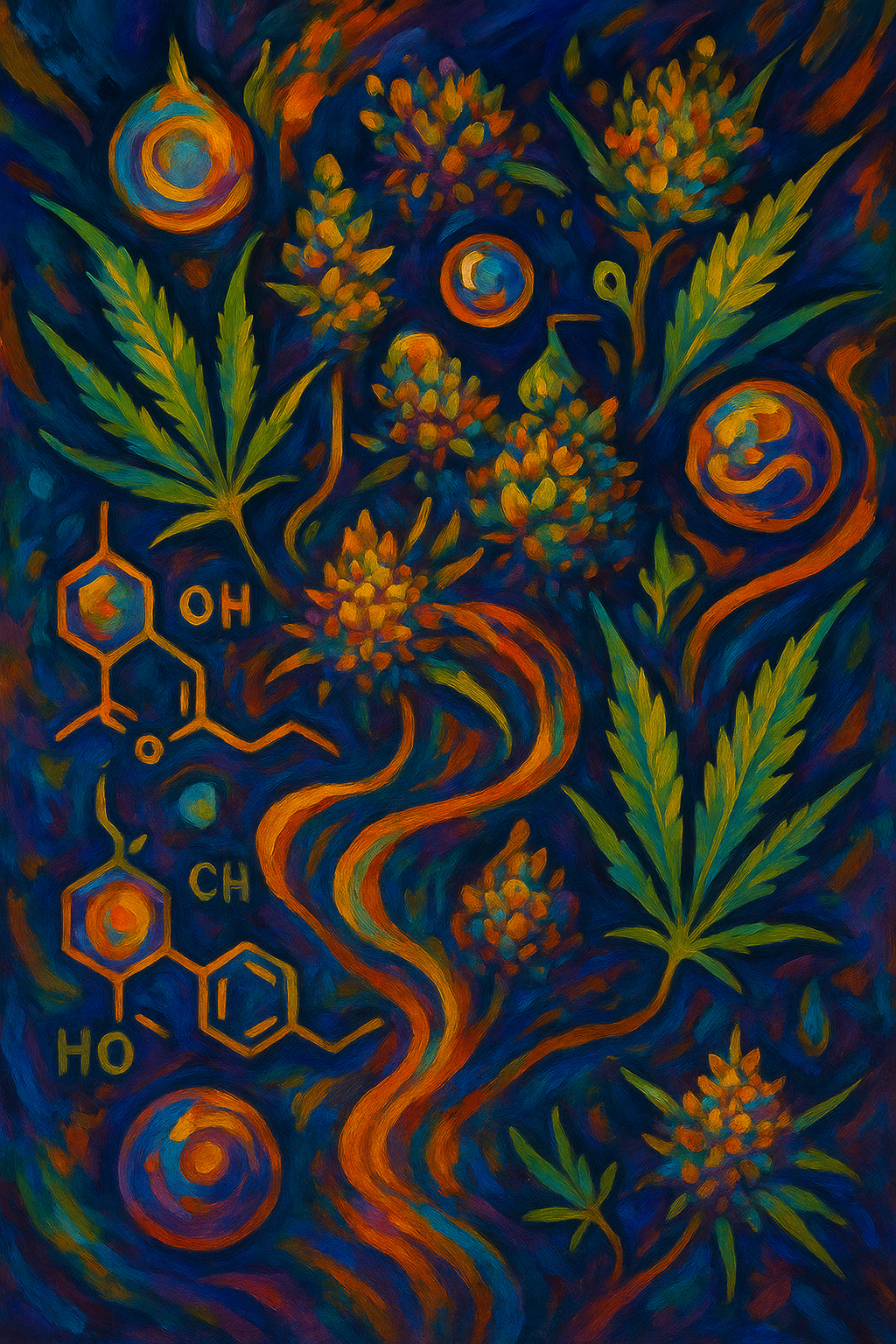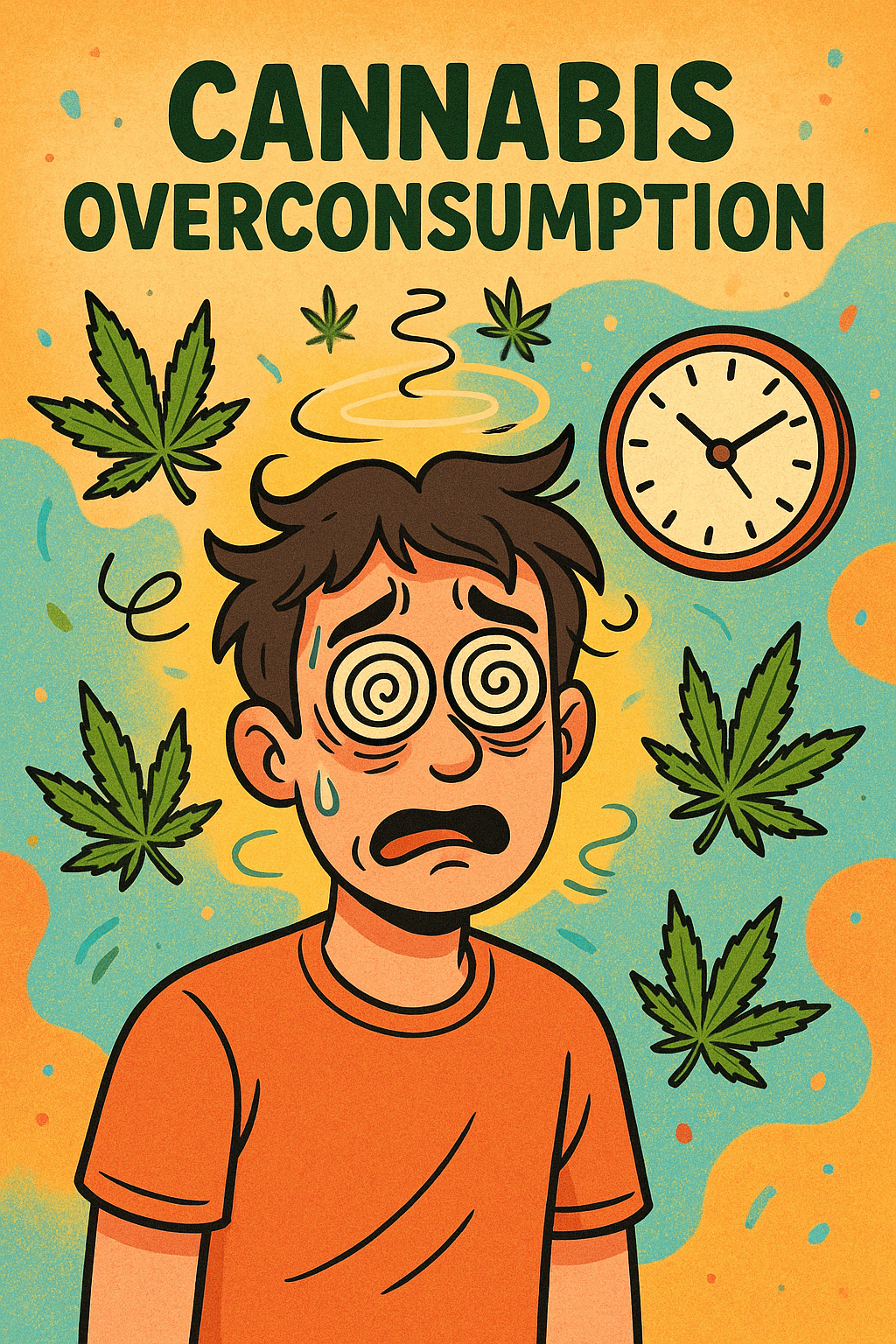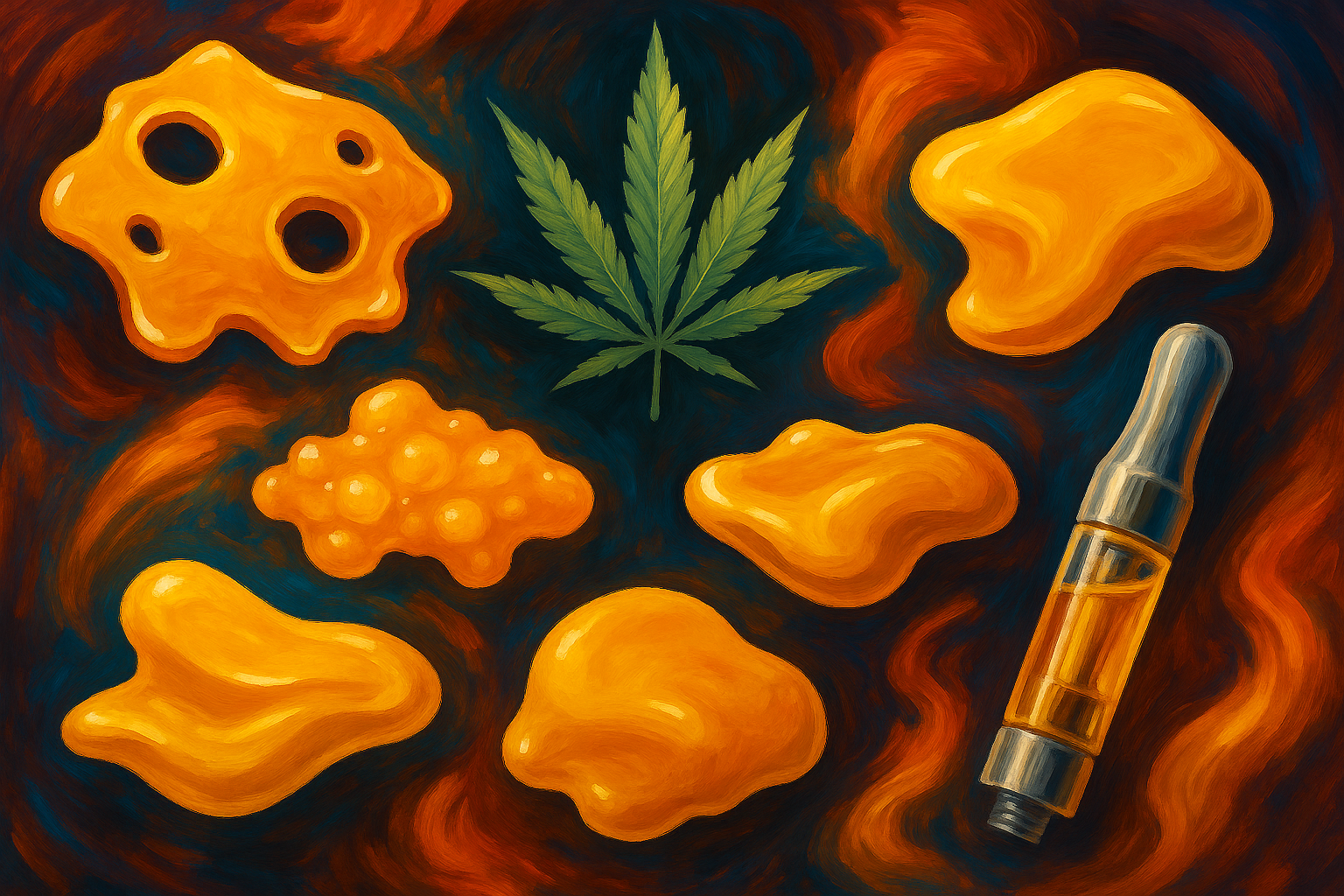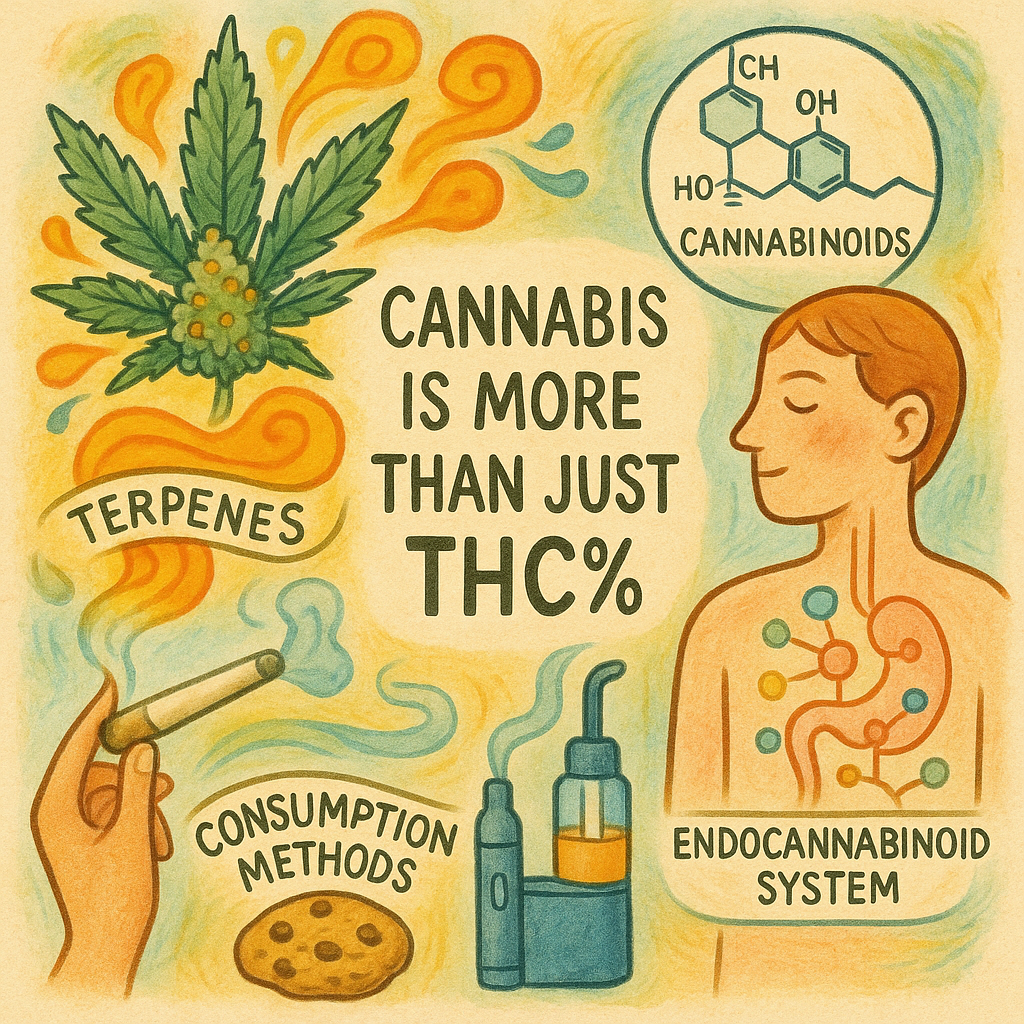Beyond the well-known THC and CBD lies a diverse family of over 100 minor cannabinoids, each offering unique therapeutic properties and effects that are revolutionizing our understanding of cannabis medicine. These lesser-known compounds, including CBG, CBC, CBN, THCV, and CBDV, are emerging as targeted solutions for specific health conditions while driving a rapidly expanding market projected to reach over $30 billion by 2030 [1][2].
The Roach: 5-Minute Quick Hit
Everything You Need to Know About Minor Cannabinoids Right Now
Minor cannabinoids are the "supporting cast" in cannabis that are quickly becoming stars in their own right[3][4]. Unlike THC and CBD, these compounds typically appear in concentrations of 0.1-2% in most cannabis strains, but don't let their small percentages fool you—they pack significant therapeutic potential[3].
The Big Players: CBG acts as the "mother cannabinoid" and precursor to other compounds, offering anti-anxiety and anti-inflammatory benefits without psychoactive effects[5][6]. CBC provides powerful anti-inflammatory and antimicrobial properties[7]. CBN has gained fame as nature's sleep aid, with 2024 clinical trials confirming its ability to reduce nighttime awakenings[8]. THCV works as an appetite suppressant and may help with weight management, earning the nickname "diet weed"[9][10]. CBDV shows promise for epilepsy treatment, similar to CBD but with unique properties[11][12].
The Market Reality: The minor cannabinoids industry exploded from $18.79 billion in 2024 and is projected to grow at 8.2% annually, reaching $30.16 billion by 2030[1][2]. This growth reflects increasing consumer interest in targeted therapeutic effects rather than broad-spectrum intoxication[13].
Safety and Access: Most minor cannabinoids are non-psychoactive and generally well-tolerated, though research is still catching up to consumer demand[14][15]. Products are increasingly available at licensed dispensaries, with biosynthetic production methods making previously rare compounds more accessible[16].
Bottom Line: Minor cannabinoids represent personalized cannabis medicine—specific compounds for specific needs rather than one-size-fits-all solutions[17].
The Weekly Dab: Complete Cannabis Education
Understanding the Chemical Foundation
Minor cannabinoids emerge from the same biosynthetic pathway that produces THC and CBD, beginning with cannabigerolic acid (CBGA) as the universal precursor[3][6]. This "mother cannabinoid" gets converted by specific enzymes into various acidic forms—THCA, CBDA, and CBCA—which then decarboxylate through heat or time into their neutral, active forms[3].
Cannabinoid Biosynthesis Pathway: From CBGA to Major and Minor Cannabinoids
The structural similarities between these compounds explain their overlapping yet distinct effects[3]. Each minor cannabinoid interacts differently with the body's endocannabinoid system, including CB1 and CB2 receptors, as well as other receptor systems like TRP channels and adrenergic receptors[6][18].
The Major Players: Individual Cannabinoid Profiles
Cannabigerol (CBG): The Non-Psychoactive Powerhouse
CBG has emerged as one of the most promising minor cannabinoids, with groundbreaking 2024 clinical research confirming its anti-anxiety properties[5]. Washington State University researchers found that 20 mg of hemp-derived CBG significantly reduced anxiety at 20, 45, and 60 minutes after ingestion compared to placebo, with stress ratings also decreasing[5].
CBG works through multiple mechanisms, acting as a partial agonist at both CB1 and CB2 receptors while strongly activating α2-adrenoceptors[6]. This unique receptor profile contributes to its anti-inflammatory, neuroprotective, and mood-regulating effects without the psychoactive properties associated with THC[6].
Cannabichromene (CBC): The Anti-Inflammatory Specialist
CBC stands out for its potent anti-inflammatory and antimicrobial properties, making it particularly valuable for conditions like arthritis and inflammatory bowel diseases[7]. Unlike many cannabinoids, CBC shows minimal activity at traditional cannabinoid receptors, instead primarily engaging with TRP channels to produce its therapeutic effects[3][7].
Research indicates CBC may help manage chronic pain while supporting neurogenesis—the creation of new brain cells—which could have significant implications for neurodegenerative diseases[7]. Its antibacterial and antifungal properties add another dimension to its therapeutic potential[7].
Cannabinol (CBN): The Sleep Solution
CBN has gained widespread attention as a natural sleep aid, with 2024 clinical trials providing the first solid evidence for its effectiveness[8]. A double-blind, placebo-controlled study found that individuals receiving 20 mg CBN demonstrated significantly reduced nighttime awakenings and overall sleep disturbance compared to placebo, without impacting daytime fatigue[8].
CBN forms naturally as THC degrades over time, explaining why aged cannabis often produces sedating effects[3]. It acts as a partial agonist at CB1 receptors and a full agonist at CB2 receptors, contributing to its mild psychoactive and sleep-promoting properties[3].
Tetrahydrocannabivarin (THCV): The Appetite Regulator
THCV presents a fascinating paradox in cannabinoid pharmacology—it can either block or activate CB1 receptors depending on the dose[9][10]. At low doses, THCV acts as a CB1 antagonist, potentially suppressing appetite and increasing energy metabolism, leading to its nickname as "diet weed"[9][10].
Recent clinical research supports THCV's potential for weight management and metabolic health[19]. A 2025 study found that THCV/CBD strips were associated with statistically significant weight loss, decreases in abdominal girth, systolic blood pressure, and cholesterol levels[19]. Animal studies suggest THCV may improve glucose metabolism and reduce insulin resistance, making it relevant for type 2 diabetes management[10][20].
Cannabidivarin (CBDV): The Seizure Stopper
CBDV shares structural similarities with CBD but demonstrates unique anticonvulsant properties through different mechanisms[11][12]. Clinical evidence from epilepsy patients shows CBDV can significantly reduce seizure severity and frequency, with molecular studies confirming its effects on seizure-related gene expression[11].
Therapeutic Applications of Major Minor Cannabinoids - Evidence-Based Assessment
A compelling case study documented a patient with drug-resistant epilepsy who experienced dramatic clinical improvement after cannabis use, with high CBDV plasma concentrations correlating with reduced seizure activity[12]. Research suggests CBDV may work through GABAergic (The GABAergic system is a network of neurons in the brain and central nervous system that produce and use the neurotransmitter GABA (17). GABA is an inhibitory neurotransmitter that helps to regulate the activity of neurons and maintain balance in the nervous system) mechanisms, enhancing the brain's primary inhibitory neurotransmitter system[12].
Emerging Synthetic Cannabinoids
Delta-8 THC and HHC: The Legal Gray Area
Delta-8 THC and hexahydrocannabinol (HHC) represent the newer wave of minor cannabinoids, often produced through chemical conversion rather than natural extraction[21][22]. Delta-8 produces euphoric effects similar to Delta-9 THC but with reportedly less anxiety and paranoia[21]. HHC offers THC-like experiences with potentially greater stability and legal ambiguity[22].
Both compounds exist in legal gray areas, with federal hemp-derived status but varying state regulations[22]. Safety concerns have emerged, with poison control centers reporting increased calls related to these synthetic cannabinoids, particularly among pediatric patients[23].
Production and Market Dynamics
The minor cannabinoids market has experienced explosive growth, driven by technological advances in extraction and biosynthetic production[1][2]. Traditional extraction from cannabis plants yields limited quantities due to low natural concentrations, prompting innovation in alternative production methods[24][16].
Minor Cannabinoids Market Growth Projection (2024-2030)
Biosynthetic production using engineered yeast and bacteria has revolutionized minor cannabinoid availability[16]. Companies can now produce cannabinoids like CBC and CBG through fermentation processes, dramatically reducing costs and increasing purity compared to plant extraction[16]. This biotechnological approach allows for consistent, scalable production independent of agricultural variables[16].
Clinical Research Landscape
The clinical research pipeline for minor cannabinoids continues expanding, with 2024 marking a significant year for human studies[25][26]. The National Center for Complementary and Integrative Health convened researchers specifically to explore minor cannabinoids' analgesic properties and underlying mechanisms[25].
Current research priorities include understanding receptor interactions, optimizing dosing protocols, and identifying specific therapeutic applications for individual cannabinoids[25][26]. The shift from preclinical animal studies to human clinical trials represents a crucial maturation of the field[5][8][19].
Safety Profile and Drug Interactions
Minor cannabinoids generally demonstrate favorable safety profiles compared to traditional pharmaceuticals, with most being non-psychoactive and well-tolerated[14][15]. Common side effects, when they occur, typically include mild symptoms like dry mouth, drowsiness, or gastrointestinal discomfort[14][15].
However, drug interactions present important considerations, particularly with cytochrome P450 enzymes[27][28]. CBD and potentially other cannabinoids can inhibit liver enzymes responsible for metabolizing many medications, potentially altering drug levels and effects[27][28]. This interaction is particularly relevant for medications with narrow therapeutic windows, such as blood thinners and certain psychiatric medications[28].
Regulatory Framework and Quality Control
The regulatory landscape for minor cannabinoids remains complex and evolving[29][30]. While hemp-derived cannabinoids enjoy federal legal status under the 2018 Farm Bill, FDA oversight continues developing, with particular attention to food and dietary supplement applications[29].
Quality control represents a critical consumer protection issue, with studies revealing significant discrepancies between labeled and actual cannabinoid content in many products[15]. Laboratory testing protocols, originally developed for THC compliance, are expanding to include comprehensive minor cannabinoid profiling[30].
| Cannabinoid | Psychoactive | Primary Effects | Receptor Activity | Clinical Research Status | Typical Concentration in Cannabis |
| CBG (Cannabigerol) | No | Anti-anxiety, Anti-inflammatory, Neuroprotective | CB1/CB2 partial agonist, α2-adrenoceptor agonist | Human trials completed (2024) | 0.1-2% |
| CBC (Cannabichromene) | No | Anti-inflammatory, Pain relief, Antimicrobial | CB1/CB2 weak activity, TRP channels | Preclinical studies | 0.1-1% |
| CBN (Cannabinol) | Mildly | Sedating, Sleep aid, Appetite stimulant | CB1 partial agonist, CB2 agonist | Human sleep studies (2024) | 0.1-1% |
| THCV (Tetrahydrocannabivarin) | Low doses: No, High doses: Yes | Appetite suppressant, Energy boost, Weight management | CB1 antagonist (low dose), CB1 agonist (high dose) | Human diabetes/weight studies | 0.1-2% |
| CBDV (Cannabidivarin) | No | Anti-seizure, Anti-nausea, Neuroprotective | CB1/CB2 minimal, TRP channels | Human epilepsy trials | 0.1-1% |
| Delta-8 THC | Yes (Milder than THC) | Euphoric, Relaxing, Pain relief | CB1 agonist (lower affinity than Delta-9) | Limited clinical data | Trace (usually synthesized) |
| HHC (Hexahydrocannabinol) | Yes (Similar to THC) | Euphoric, Relaxing, Similar to Delta-9 THC | CB1/CB2 agonist | Minimal research | Trace (usually synthesized) |
| CBGA (Cannabigerolic Acid) | No | Anti-inflammatory, Antimicrobial, Antioxidant | Precursor compound | Preclinical studies | 1-5% (raw cannabis) |
| THCA (Tetrahydrocannabinolic Acid) | No | Anti-inflammatory, Raw form of THC | Precursor to THC | Preclinical studies | 5-25% (raw cannabis) |
| CBDA (Cannabidiolic Acid) | No | Anti-nausea, Anti-inflammatory, Raw form of CBD | Precursor to CBD | Limited clinical data | 1-10% (raw cannabis) |
Therapeutic Applications and Consumer Guidance
The therapeutic potential of minor cannabinoids spans numerous medical conditions, from anxiety and sleep disorders to inflammatory diseases and metabolic dysfunction[17]. Unlike broad-spectrum cannabis products, minor cannabinoid isolates and targeted formulations allow for precision dosing and specific therapeutic targeting[17].
Consumer education remains crucial as the market expands faster than scientific understanding[13]. The 2024 consumer trends survey revealed high confidence in perceived benefits despite limited safety and efficacy research[13]. This knowledge gap underscores the importance of continued clinical research and evidence-based product development[13].
Future Directions and Industry Evolution
The minor cannabinoids industry stands at a crossroads between rapid commercial expansion and scientific validation[25][26]. Ongoing research initiatives focus on understanding synergistic effects, optimizing delivery methods, and identifying biomarkers for therapeutic response[25].
Biosynthetic production will likely continue reducing costs and improving availability, while regulatory frameworks evolve to address safety and quality concerns[16][29]. The industry's maturation depends on balancing innovation with responsible development, ensuring consumer access to safe, effective products backed by solid scientific evidence[13][26].
Molecular Structures of Key Minor Cannabinoids: CBG, CBC, CBN, THCV, and CBDV
Conclusion: The Minor Cannabinoid Revolution
Minor cannabinoids represent the next phase of cannabis therapeutics, offering targeted solutions for specific health conditions without the broad psychoactive effects of THC[17]. As research progresses and production methods improve, these compounds are transitioning from laboratory curiosities to mainstream therapeutic options[5][8][19].
The convergence of scientific validation, technological innovation, and market demand positions minor cannabinoids as a transformative force in both medicine and wellness[1][2][25]. For consumers, practitioners, and industry stakeholders, understanding these compounds' unique properties, therapeutic applications, and safety profiles will prove essential as the cannabinoid landscape continues evolving[13][26].
The minor cannabinoid revolution has begun, promising more precise, personalized approaches to cannabis-based therapy while expanding our understanding of this remarkable plant's therapeutic potential[17][18].






Leave a comment (all fields required)